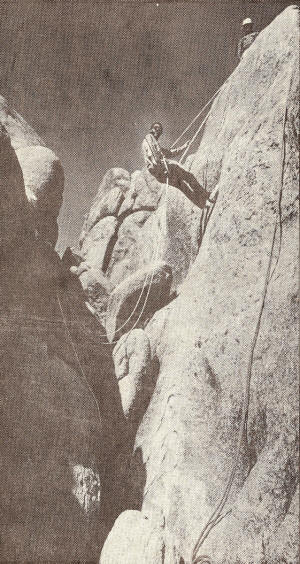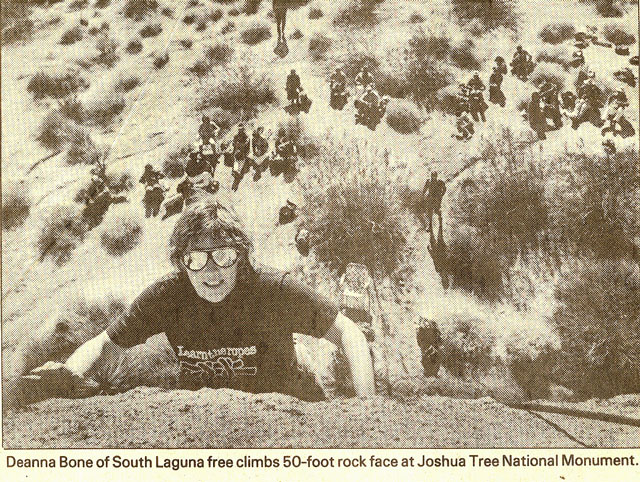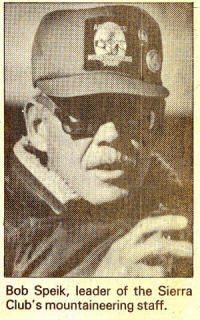 ™
™
TRADITIONAL MOUNTAINEERING
™
www.TraditionalMountaineering.org
™ and also
www.AlpineMountaineering.org
™
 ™
™
FREE BASIC TO ADVANCED ALPINE MOUNTAIN CLIMBING INSTRUCTION
™
Home
| Information
| Photos
| Calendar
| News
| Seminars
| Experiences
| Questions
| Updates
| Books
| Conditions
| Links
| Search
![]()
Sierra Club's BMTC climbing instruction at Joshua Tree in 1985
ROOM AT THE TOP
Sierra Club Leads the Way to Life's Peaks
The Los Angeles Times, View Section
March 28, 1985
Story by BOB SIPCHEN / Photos by DON TORMEY
I'm going to show up at work tomorrow all black and blue. They're going to think
someone beat me up," Jeannette Hauser said, leaning over a seat on the bus that
was hauling her mildly battered body back across the Mojave Desert toward Orange
County California.
In the seats around her, other members of the Sierra Club's Basic Mountaineering
Training Course-high school students, retirees and folks from almost every age
level and
occupation in between-were talking, guzzling beer, eating ice cream, sleeping.
These same folks 36 hours earlier had stumbled groggily through a dark Anaheim
Orange County
parking lot and onto one of four idling buses, their bright foul-weather gear
dripping cold, pre-dawn rain. Now they were exhausted.
Two days in the wind and sun at Joshua Tree National Monument had brought out
the first pink skin and freckles of the year, and the sleepy, edgy babbling of
the previous
morning had been replaced by the frank, sometimes giddy conversation of budding
camaraderie.
"When I saw this group at our first meeting I thought, 'Oh no!' They looked
dull," confided ,Roger Blackwell, 23, an electrical engineer from Cypress, as
the bus rolled
homeward, past the snow-capped peaks of San Gorgonio and San Jacinto. "But we've
done some dangerous things together now, and that's made us closer."
The Basic Mountaineering Training Course was begun in 1961 by the Angeles
chapter of the Sierra Club to teach the skills of safe mountain climbing.
Interest grew, the
program expanded, and there are now five sections (in the San Fernando Valley,
West Los Angeles, Long Beach-South Bay, San Gabriel Valley and Orange County),
each with nine evening meetings and four mandatory field trips.
With more than 10,000 graduates to date and about 1,000 students enrolled
throughout Southern California, the course is probably the most popular of its
kind in the country.
With its examinations, pep talks, "experience trips" rated according to
difficulty and patches to be earned for skills, it is a bit like Boy Scouts for
adults. By the time they
went to Joshua Tree, the Orange County mountaineering students had already sat
through half a dozen meetings featuring films, lectures and workshops on skills
such as
map and compass navigating and rock climbing, and had survived a 15-mile
conditioning hike through the Santa Ana Mountains.
The course is run by volunteers, explained Bob Speik, 57, a mortgage banking
executive from Fullerton who is current director of the program.
"The sport of mountaineering appeals to technically minded, goal-oriented people
- the purpose, after all, is to reach the top of peaks," Speik said. And, he
added, the
program's executive committee doesn't hesitate to draft graduates with
specialized skills into its service. He said more than 250 volunteers currently
are devoting four to 50
or more hours a week to conducting the course.
Volunteers who want to become group leaders must pass an advanced mountaineering
course, complete leadership training and survive a field apprenticeship.
Professional Know-How
Many volunteers apply their city-learned skills to the logistics of the course,
Speik says. For instance, the treasurer overseeing the program's $100,000 yearly
budget is also finance director of the City of Paramount. Hollywood pros work on
training films, doctors and nurses lecture on mountaineering first aid, and
management types orchestrate
the potentially chaotic car pools and bus trips to the mountains.
The program has become so big that the U.S. Forest Service last year advised the
group that the human waste left behind on field trips in the Sierra Nevada each
winter was causing an odor problem in the spring. Now, some mountaineers who
work as engineers at the Jet Propulsion Lab, Pasadena, are brainstorming to come
up with an efficient waste management method for the wilderness, Speik said.
"I think one reason leaders keep coming back is because they see the
appreciation from new students who've overcome their fear of a danger, real or
perceived," observes
Speik, who said he evolved from car camper to backpacker to full-fledged
mountaineer during the '70s. "You see this almost ecstatic response from someone
who's
accomplished something they never thought they could do, and that's rewarding."
At the beginning of their Josh Tree trip, groups of about 20 students each
quickly pitched clusters of colorful nylon tents, then off on a
follow-the-Ieader type warm-up
exercise. Some students scrambled over the often-sharp quartz monzonite rocks
with the assurance of the indigenous gecko lizard. Others had to be coaxed, step
by step.
"I was petrified. I have a deathly fear of heights," Jeannette Hauser said, back
on flat ground. "I remember as a kid, I could climb the jungle gym, but when I
got to the top
and looked down, I'd panic."
A financial analyst at Hughes Aircraft, El Segundo, Hauser is active in the
Sierra Club's Orange County singles group, the activities of which, she
explains, are some times
no more outdoorsy than a grueling trek around a Trivial Pursuit board. But
Hauser hopes to become a leader on Sierra Club backpacking trips and feels she
needs to learn more about mountaineering skills to be a responsible leader.
"Besides," said Hauser, who will be 30 this year, "time goes so much faster as
you get older. You become more aware of your mortality. This is something I've
always
wanted to do, but I was afraid. Now I'm going to do it"
A couple of hours later, Hauser was contemplating her mortality from a new
perspective. Her group had moved over to an outcropping of boulders through
which the group
leaders had strung a tangle of climbing ropes. Securely roped in, students
clambered over the rock pile like children on the jungle gym of Hauser's
childhood.
Coaching From Below
After a couple of relatively easy climbs, Hauser found herself about 15 feet
off the ground, wedged into a vertical gash in the rock.
As another student patiently held the rope securing her, Hauser contorted her
body to fit the crack, banging elbows and dinging knees in the struggle.
From the ground, leaders and students called out suggestions: "feel over to your
left, there's a little knob there."
Hauser's hand scratched for a grip. Her jogging shoe grated against the cold
quartzite. Finally, leader Julie Marino, of Garden Grove, climbed the wall
beside the crevice and calmly talked Hauser out of the stalemate, from handhold
to foothold, all the way to the top.
As the day progressed, word got around the rock pile that the "big rappel" had
been set up. Completing the battery of tests, students scrambled through the
boulder piles,
shimmied up a narrow rock chimney and onto a ledge.
A cold wind whimpered over the rocks, making balance uncertain, but students
dutifully pulled on helmets, secured themselves to a line held by a student
belayer and
prepared to make a Dulfersitz rappel.
Wrapping a second line through their legs, over a shoulder, then back under an
arm, they practiced how they'd use the friction between the rope and their
bodies to lower
themselves. Then, one by one, they stood with their backs to the breathtaking
desert panorama below, quietly building up courage.
'Most Catatonic Student'
On the rock, Speik soothed each new arrival with assurances and last-minute
advice. Then he verbally nudged them into doing something blatantly unreasonable
-stepping
backwards off the edge of the cliff.
It took more than a bit of cajoling to get Jeannette Hauser to take the big
step.
"She's catatonic," Speik said, as Hauser edged toward the cliff. "She's the most
catatonic student I've ever had."
In a gesture of moral support, assistant leader Ann Kominski had tied into a
second rope and lowered herself down the face of the rock. With that
reassurance, Hauser
leaned back into the correct stance, then let the rope slide through her
fingers. Very slowly, she walked backwards down the rock, landing to cheers and
shouts of
congratulations.
"My legs were trembling like leaves on a tree," Hauser said. "I looked up and
was awestruck that I'd made it down that rock."
She wasn't alone in her apprehension.
Greg Feinberg, of Santa Ana, watched intently from a rock perch as 18- year-old
Liv Hukset adorned herself with the red-and-white climbing ropes. A Riverside
firefighter,
Feinberg learned to rappel as part of his job. Hukset, an exchange student from
Forde, Norway, who is living with Feinberg and his family, had had no such
experience to
draw upon.
"I wrote a letter to my boyfriend back home, and my mother heard about what I'm
doing through him," Hukset said as she edged toward the precipice. "She's scared
to
death."
"What do you say before you get out there?" Kominski asked in a last-minute
reminder of the signals the students had learned.
"God be with me?" Hukset asked.
Kominski shook her head. "On belay?" Hukset tried meek1y. Then she added: "I'm
scared."
"No, you're not," Speik assured her
"I'm shaking! . . . I'm shaking!' she said, inching a half step closer to the
drop.
"Everyone shakes," said Jim Kominski, the leader of the group and Ann's husband
(they met in a mountaineering class, married, spent their honeymoon
rockclimbing, and,
later that year, ascended Mexico's highest volcano.
A moment later, Hukset let out some slack on the rope, disappeared over the edge
of the rock slab and, after a slow but sure descent, touched the ground 50 feet
below.
Two weeks after their weekend at Joshua Tree, the students again were up at 4
a.m., this time to assault a snow -covered Mount Baldy with their newly acquired
skills with
the mountaineering ice ax. As, the leaders watched, students flailed and
tumbled, slowly learning how to jam the sharp ax into the snow to stop an
unwanted descent.
Again, Hauser came back black and blue.
A couple of days before she was to face the final field trip of the class-two
days and two nights in the snow-swept high Sierra-Hauser reflected on what she'd
learned.
"I took (the course to learn the technical skills so that I could deal with
emergencies in the wilderness," she said. "I got more out of it than I expected.
"Frankly, I never thought I'd do some of the things we've done. I thought I'd
back down, psyche myself out. But the course has given me self-confidence. Now,
I think I could
gather the courage to overcome a life-or-death situation if I were leading a
trip. It's taught me that if I'm determined enough, I can do just about
anything."
The Los Angeles Times - Room at the Top



Personal comments
Note: In the mid 1980s, Robert Speik was Chair for three years of the
Mountaineering Training Committee (MTC) of the Sierra Club's large Angeles Chapter in
Southern California. The Committee was responsible for the training up to 1,000
people per year in Basic and Advanced Mountaineering Training with more than 250
volunteer Leaders in five geographical areas, qualified in several levels of
technical competence and responsibility. Bob Speik edited a new MTC Staff Handbook in 1985, writing the chapter on technical Snow Climbing.
Recently, he has conducted popular class room and field classes in several
mountaineering subjects for Central Oregon Community College in Bend
Oregon. He is the author of the popular website TraditionalMountaineering.org
-- Margaret Thompson Speik
![]()
Read more . . .
About Alpine Mountaineering:
Interesting essays reviewed monthly
The Sport of Alpine Mountaineering
Climbing Together
Following the Leader
The Mountaineers' Rope
Basic Responsibilities
![]()
The Ten Essentials
ALPINE CLIMBING
ON SNOW AND ICE
How long is the traditional alpine mountaineering ice axe?
What about climbing Mt.
Hood?
What is a good
personal description of the south side route on Mount Hood?
What should I know about travel over hard snow
and ice?
How can I learn to self belay and ice axe arrest?
6 pdf pages ![]()
What should I know about snow caves?
What should I know about climbing Aconcagua?
TECHNICAL
MOUNTAINEERING
What is the best traditional alpine mountaineering
summit pack?
What is the best belay | rappel | autoblock device for traditional alpine
mountaineering?
What gear do you normally rack on your traditional alpine
mountaineering harness?
Photos? ![]()
What is the best traditional alpine mountaineering seat harness? Photos?
Can I use a Sharpie Pen for Marking the Middle of the Climbing Rope?
What are the highest peaks in
Oregon? Alphabetically?
CARBORATION
AND HYDRATION
What's wrong with GORP? Answers
to the quiz!
Why do I need to count carbohydrate calories?
What should I know about having a big freeze-dried dinner?
What about carbo-ration and fluid
replacement during traditional alpine climbing? 4 pages in pdf
![]()
What should I eat before a long day of alpine climbing?